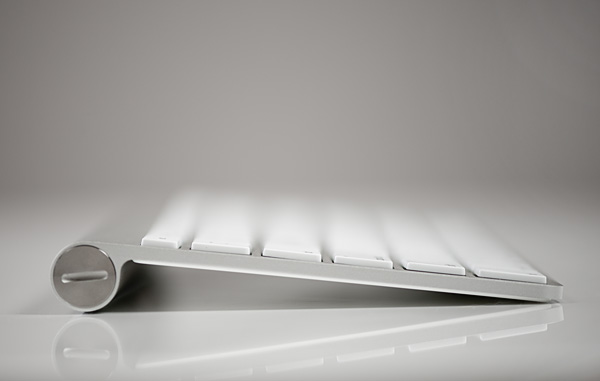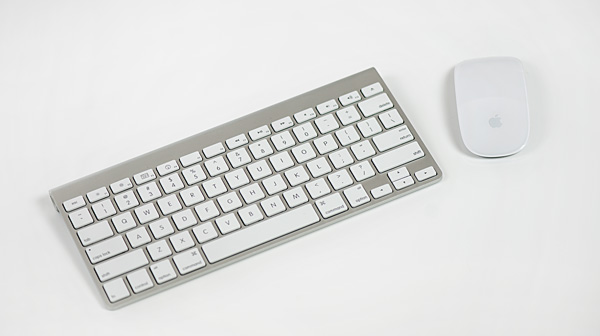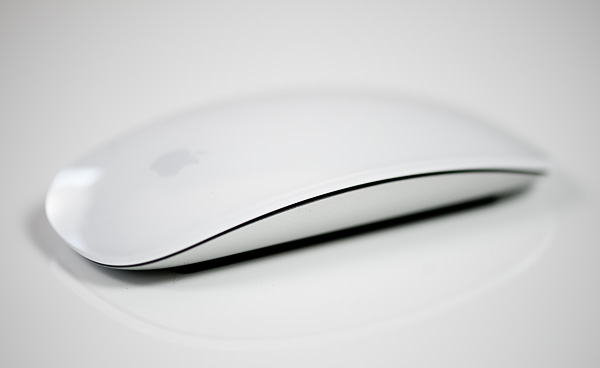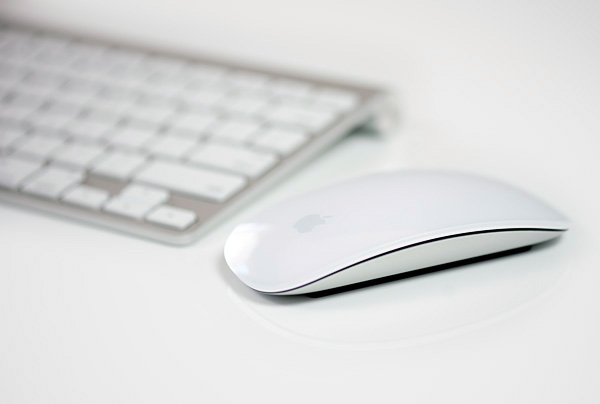The 27-inch Apple iMac Review (2011)
by Anand Lal Shimpi on May 27, 2011 2:30 AM ESTThe Peripherals
I've never been a fan of wireless peripherals - I didn't want more things to charge. Last year I finally broke down and bought a wireless mouse: Microsoft's Wireless Mobile Mouse 4000. I didn't buy it for mobility, I just liked the form factor.
The iMac comes with all wireless peripherals. In fact, if you stick with WiFi for network access, there's only a single cable you need going to the iMac: power. By default you get Apple's Wireless Keyboard and a Magic Mouse.
The Wireless Keyboard is a Bluetooth keyboard that runs off of two AA batteries. It pairs effortlessly with the iMac and I didn't encounter any issues with interference in using it. The keyboard seems to burn through batteries quicker than the mouse, perhaps that's because I type far too much or there's an issue with power management under OS X. After a week of use I'm down to 81% on a fresh pair of batteries (this is my second set).
The keyboard itself is a lot like Apple's standard aluminum keyboard, just wireless and more compact. Apple chopped off the dedicated home/end key island as well as the numeric keypad. Under OS X Cmd + Left/Right Arrow take the place of Home/End for me so part of the sacrifice isn't a problem, but the missing numeric keypad is. I do entirely too much data entry (ahem, benchmarks) to not have a dedicated numeric keypad, and for some reason Apple doesn't offer the Wireless Keyboard with one.
If you don't type tons of numbers every day however, the Wireless Keyboard is really nice. Apple had to stick a function key to the left of the control key, which is a bit bothersome (leave my control/option/cmd row alone) but it's nothing you can't get used to. The footprint is great. I have a giant desk, but I always seem to run out of desk space. The Wireless Keyboard makes it so that I can reclaim a small amount of high value desk area.
Typing feel and keyboard angle are both great - no complaints there. I'm a fan of Apple's keyboards.
Pointing devices designed in Cupertino are another story entirely. I've never liked Apple's mice. It was a big enough problem that when I first tried my Month with a Mac experience I ditched Apple's mouse. There was no way I was going to give the platform a fair shake if I had to use that thing. Since then Apple has at least enabled double clicking - the surface of the Magic Mouse is touch sensitive, click with your right finger and you get a right click. The Magic Mouse has no scroll wheel but drag your finger around on its surface and you get the best scrolling experience on a physical mouse.
The Magic Mouse is also a Bluetooth device that quickly pairs with the iMac. I noticed under Windows there's always a second or two of lag before it recognizes the mouse whereas it's useable as soon as you can see it under OS X.
My complaints about the Magic Mouse are three-fold. As I've mentioned before, the Magic Mouse doesn't have soft rubber feet that glide around on your desk. Instead you get two hard plastic strips that just seem to scrape against all surfaces. Tracking isn't a problem, but it's not a pleasant experience.
The other issue I have is the form factor itself. Microsoft's Wireless Mobile Mouse 4000 is small but it has a nice curve to it that seems to match my hand very well. The Magic Mouse on the other hand doesn't conform to any part of my body. I can lay my hand flat on it but either I'm not conditioned to do that or that's not a very comfortable way to use the mouse for long periods of a time.
Finally there's the clicking noise it makes. Modern mice seem to have a solid but more muted click, whereas the sharp click of the Magic Mouse reminds me of the past decade of Apple mice. I assume that's what Apple was going for, but Apple's market share has grown considerably in the past 10 years - it's ok to let go of some traditions.
Apple does offer the Magic Trackpad as a no-cost option. I have a love/hate relationship with the Magic Trackpad as a pointing device. Scrolling and gestures are great on it, but I prefer a normal mouse for most everything else.
















139 Comments
View All Comments
smithj - Sunday, May 29, 2011 - link
People not within the European Union do not pay the VAT tax. If you live outside of the European Union, you pay £369.00 which is around $570 USD/AUD so he's completely correct.Even if you live in the European Union, you're going to be saving a similar amount since I imagine Apple products get the VAT tax slapped onto them as well. Doesn't change anything.
On the Hazro website:
"If you are ordering from outside the UK and EU, you will not be charged VAT."
There are extremely good reasons for getting a iMac but from a parts point of view its terrible value. You can't measure the benefits of the iMac however with just plain figures and specs.
Kristian Vättö - Sunday, May 29, 2011 - link
Ahh, that explains it then. I didn't look any further so didn't know about the international price. Customs may be added to the price though (not sure about the US policy as you don't VAT. If I buy something from the US, I will have to pay the Finnish 23% VAT before I can receive it).The Hazro looks very good though, thanks for linking it. Something to keep in mind when this oldish iMac needs to go. 500€ for a 27" 1440p display doesn't sound that bad, could get two of them for the price of one 27" ACD
repoman27 - Sunday, May 29, 2011 - link
I took issue with OWC's blog posts about the HDD upgrade issues in the 2011 iMac, and was hoping to find a better clarification here than the one in this review. OWC insisted on using the terms "standard", "leads" and "pins" in odd ways, and some of that seems to be echoed here.The HDD power cable in the iMac (Mid 2011) has 7 conductors, a standard 15-pin SATA power connector on one end, and a small 7-socket connector on the other which attaches to a header on the logic board. This assembly, while proprietary, is not necessarily any more so than the ones that ship with modular PSUs. It is more common to see SATA power cables with only 4 conductors (GND, 5 V, GND, 12 V) or 5 conductors if 3.3 V is also supplied. Several pins are then ganged together in the 15-pin connector to support the specified current requirements. As noted in the article, Apple is using relatively small conductors, and thus 2 are used in tandem for 12 V, they also elected to use the reserved pin 11 of the 15-pin SATA power connector for temperature monitoring. Pins 10 and 12 must both be connected to ground, although most of the time one conductor is used and pins 10-12 are all ganged together. Apple couldn't do this, so instead their 7 conductors are for GND, 5 V, GND, Temp, GND, 12 V, 12 V.
It is not common behavior for HDDs to output a temperature signal on pin 11 of the SATA power connector. While the model numbers and controller boards of the drives that ship in the 2011 iMacs look to be no different from retail ones, there would appear to be differences in the firmware that allow for this functionality. I would imagine that patching the firmware of a retail drive is possible.
If you ground pin 11 of the 15-pin SATA power connector, SMC will act as if there is no 3.5" drive installed. This means that the speed of the HDD fan will not increase above a certain baseline, and if you really do have a 3.5" drive in that bay, it will not properly dissipate the heat generated by it. If you use this trick to swap out the stock drive for an after-market one, you should also use S.M.A.R.T. based fan control software.
There are separate, clearly labeled power headers for HDD, ODD and SSD on the iMac's logic board. It is probably a better idea to use the dedicated SSD power header than a Y-splitter if you add a 2.5" drive to an iMac that didn't ship with one installed. The HDD cable was more than likely not designed to support two devices, and most Y-splitters for SATA power cables gang pins 10-12, thus grounding pin 11 and preventing the SMC from receiving HDD temperature data. The SSD power header on the 27-inch models is a standard 6-pin slimline SATA power connector, but on the 21-inch it is just a small 4-pin header.
The design of the iMac in general deters the casual from servicing their own hardware, and while some are discouraged by this, it's a ridiculous stance to take. Most people who purchase a new Mercedes S-Class don't worry about the fact that they probably won't be able to service it themselves (even if they are a fairly competent mechanic), or that it contains proprietary cable assemblies. If you don't feel comfortable servicing or modding your gear yourself, just take it to someone who does.
MadMinstrel - Sunday, May 29, 2011 - link
A 512MB <i>framebuffer</i>? Really? So that's all you think GPU memory is useful for? That might have been the case in the good old S3 ViRGE days, but right now it <i>really</i> doesn't work that way and I would expect someone writing for AnandTech to know that. In fact, GPU memory holds at least two framebuffers and sometimes as many as 6. More if you count all the intermediate rendering steps such as depth buffers, accumulation buffers, G-buffers, albedo buffers, etc, as used in modern deferred rendering engines. Textures, geometry, physics data, and sometimes even some of the game logic also go into GPU memory. Maybe I'm just being pedantic about this but I guess it really annoyed me because I actually <i>care</i> about Anand being accurate.Sunburn74 - Monday, May 30, 2011 - link
Not for me thanks. Too pricey and lousy specs. I also don't care about TN vs IPS panels. Most people don't care. Some enthusiasts do, but you can't really argue that iMacs are targeted for the average joe who don't know a ton about pcs and just wants it to work whilst arguing that the average joe can appreciate a 500 dollar difference between an IPS panel and TN panel. The truth is most people don't even know there are 2 types of panels floating about.I consider myself an enthusiast. I've spent a couple months working on a last gen 27inc iMac in the past as a reference point, with a lot of adobe studio stuff. Long story short, I wasn't impressed. I found the machine to be slow to average in terms of performance (compared to the HP tower workstations we had down the hall for "real work" haha). Throw out the nicer display (who's value is questionable depending on who you talk to. Again I've read in the comments how imacs are great for your dad and mom and your granny.Your granny is not noticing a difference between a 27inch HP tn panel and a 27inch mac IPS panel) and I don't really see what the iMac brings to the table that all the other all in ones don't have. I just don't really see a good target audience outside of mac enthusiasts who just gotta have it.
Its not great for people who need a pc that just works without hassle but are limited by budget (your mom, your dad, your granny, your girlfriend in college)
Its not great for the power users like myself who render and process in different ways thousands of high def images a day for scientific purposes. The HP workstation crushed the mac with its superior specs and apparently less aesthetic screen (a high end HP 30 inch TN panel).
Its not great for the true computer enthusiasts who likes to know whats in his pc and enjoys servicing his own box.
the iMac is truly like the mercedes benz and not in a good way. Mercedes make nice cars, but no one can disagree that those cars (just like the iMac) are
1)For the rich for whom cost is not truly an issue
2)for those who don't have an interest in servicing and maintaining their own cars and will have the dealer do it all,
3) For those who don't use their cars for actual work where the performance of the car actually matters (otherwise they'd go with the mac workstation or any othre workstation or build their own).
The imac just puzzles me and yet it sells so well apparently.
JFA - Tuesday, July 26, 2011 - link
It would be great to see comparison with previous generation of iMacs. Nowadays one can find quite a discounts on previous gen.javaporter - Tuesday, September 27, 2011 - link
I didn't read all 14 pages of comments, someone probably mentioned this, but you might want to look at dropbox. I have the 50GB option. It's enough for core project folders, my 1Password keychain, and various things I want to always have access to.I had the same issue as the author when deciding to leave a Mac Pro for a Macbook Pro. I did and worked that way for a while, however, recently I went back from a MBPro to an iMac and a Macbook Air.
With dropbox, I don't really have to worry about moving files anymore. It's still not perfect; I still have to worry about 2 machines to update software on and my photos won't fit on my MBAir of course (nor will iTunes), but for me, it's still worth it to have a desktop. I liked my MBPro, but it just never seemed to be as fast or easy as the desktop or as portable as the Air (I had the 17" — pretty unusable when flying coach).
timmillea - Monday, December 19, 2016 - link
So, five years later and this is still a very attractive machine. It is the last in the line of iMacs that do not need a 'pizza cutter' and replacing double-sided tape to obtain access to upgrade. Also the last with an optical drive which is still handy for ripping movies, music and sharing the same with people who are not riding the Apple wave. A 3.4 GHz quad-core i7 with a (ideally) 2GB GPU is still a very serious amount of computing power. Upgrade to 2 x SSDs with guides freely available on the net and configure them as Raid 0 and you have Mac-Pro challanging performance with a superb display in the size of the display alone available on the Bay for a third of the original price.Rendell001 - Sunday, July 29, 2018 - link
Thats very reassuring to know timmillea, I have the same model too which I picked up on eBay back in 2014 for £900. I love it for the same reasons you do though I've not tinkered with the insides yet. Needed to know if it would still hold up even now in 2018.